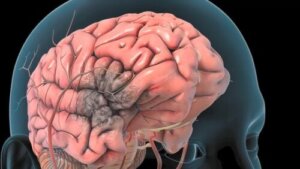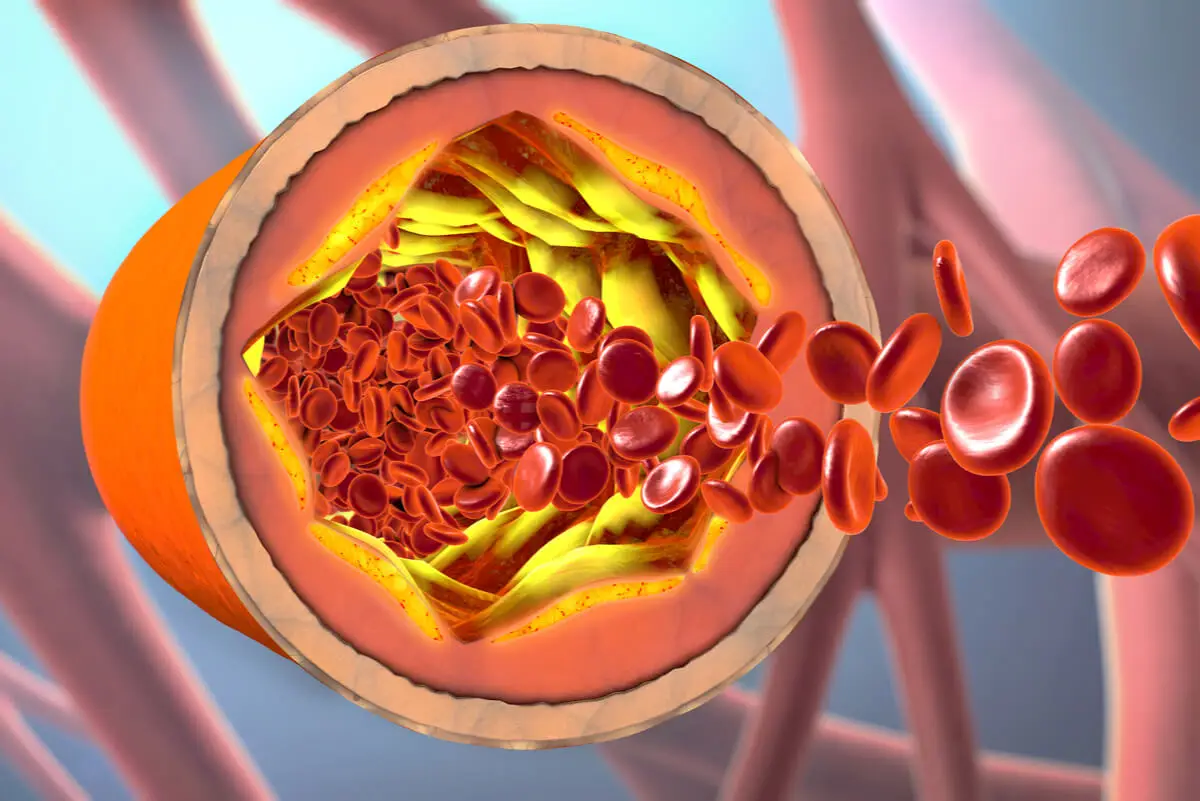Cerebral Artery Thrombosis: What It Is, Causes, Symptoms and Treatment

Cerebral artery thrombosis is a very serious health problem that can leave lifelong sequelae or even lead to death. It’s very important to learn to recognize its symptoms, as prompt attention is essential to limit the damage.
In general terms, cerebral artery thrombosis occurs when a blood clot forms in one of the arteries of the brain. This obstructs the passage of blood and causes some neurons to stop working. It may also be accompanied by bleeding in the brain.
The condition is also known as ischemic stroke. The larger the affected artery, the more serious the consequences of these events tend to be.
What is cerebral artery thrombosis?
Cerebral artery thrombosis is a form of cerebrovascular accident (CVA) that occurs when a blood clot forms. It blocks one of the arteries in the brain and prevents oxygen and nutrients from reaching a region of the brain.
The blockage in blood flow leads to a stoppage of electrical activity in an area of the brain. If the blockage persists, major disruptions in the cell membrane occur, which can lead to brain death.
Cerebral thrombosis is estimated to account for 50% of strokes. Although it’s more common in older people or those with underlying diseases, such as arteriosclerosis or arterial hypertension, it can occur in young people too.
Find out more here: What is a Brain Aneurysm? Learn About Emilia Clarke’s Condition During Games of Thrones
Causes of cerebral artery thrombosis
Cerebral artery thrombosis is considered a disease of multifactorial origin. All conditions that promote degeneration of the arterial walls, obstruction of the arteries, blood clotting, or that reduce vasodilatation, can give rise to this pathology.
Some people with certain conditions are more prone to develop this type of stroke. The risk groups can be divided into three groups:
- With atherosclerosis. There is a higher probability of cerebral artery thrombosis if there’s also hypertension, diabetes mellitus, dyslipidemia, or smoking.
- With arteritis. This group includes those who have polyarteritis nodosa, temporal arteritis, rheumatoid arteritis, disseminated lupus erythematosus, and infectious arteritis.
- Other causes. These include fibromuscular dysplasia, carotid dissection, moyamoya disease, and tumors.
People with high alcohol consumption, as well as those who smoke frequently, are more prone to develop cerebral thrombosis.

Symptoms and diagnosis
The medical condition of cerebral arterial thrombosis usually sets in gradually, but with sudden advances. Most commonly, it becomes noticeable within a few hours and, only sometimes, within days.
The main symptoms of this disease are as follows:
- Twisted mouth
- Seizures
- Difficulty swallowing
- Visual disturbances
- Severe headaches
- Loss of consciousness
- Memory abnormalities
- Dizziness and loss of balance
- Loss of control over movements
- Difficulty in speaking and understanding
- Paralysis or tingling on one side of the body
- Alterations in bowel or bladder control
Diagnosis is usually made through an MRI or CT scan. The former is a more specific test. Extra tests such as a chest x-ray, blood count, ionogram, blood gases, and blood glucose are common.
In some cases, other specific tests may be required, such as the following:
- Study of the cerebrospinal fluid
- Brain scan
- Cerebral angiography
- Transcranial Doppler
- Ophthalmodinamometry
You might also be interested in: Nine Foods that May Help Reduce Your Risk of Thrombosis and a Stroke
Treatment
If treatment is started within 4 hours of the cerebral arterial thrombosis event, what doctors normally do is to carry out thrombolytic therapy. This involves a procedure called thrombolysis, which consists of diluting the thrombus with drugs in order to restore blood flow.
The drugs are administered intravenously so that they reach the whole body, or through a catheter or tube that reaches the cerebral arteries. In the latter case, the catheter is positioned with the help of an imaging guide.
If treatment is started after 4.5 hours of the event, what should be done is to determine the cause of the thrombosis and offer secondary prevention. That is, to administer drugs to prevent new thrombus formation or further bleeding.
The patient should be admitted to the hospital for 4 to 7 days. This is considered the highest risk stage for a new event to occur. From then on, treatment is oriented to the patient’s rehabilitation.
Possible sequelae of cerebral artery thrombosis
It isn’t easy to make a prognosis during the 72 hours following the cerebral thrombosis event. The problem may stop, or continue and even lead to death. It’s also possible there’ll be some neurological damage that may or may not be reversible.
The patient’s chances of recovery depend on several factors, such as the person’s general state of health, the severity of the thrombosis, the neuronal structure affected, and the speed of care received.
Depending on all these factors, recovery can range from complete to nil. There may be sequelae, such as speech problems, psychomotor alterations, sensory difficulties, or seizure syndrome.

Can it be prevented?
The best way to prevent cerebral arterial thrombosis is to maintain a healthy lifestyle. This involves a balanced diet, as well as regular physical activity, and stress reduction.
If there’s an underlying disease, it should be kept under control.
Although it applies more to venous thrombosis, it’s advisable to avoid sitting for long periods of time. When traveling, it’s best to move around from time to time and drink plenty of fluids. Movement is also important after surgery for whatever reason.
It goes without saying that alcohol consumption and smoking should be avoided. Both are risk factors for cerebral artery thrombosis. It’s also advisable to reduce salt intake.
Cerebral artery thrombosis is a serious problem
Prompt attention is crucial in cases of cerebral thrombosis. Drugs are much more effective when administered within 60 minutes of the event.
People who have suffered from this condition often have behavioral changes after the event. Depression and moodiness are to be expected. The support of those close to them is key to recovery.
All cited sources were thoroughly reviewed by our team to ensure their quality, reliability, currency, and validity. The bibliography of this article was considered reliable and of academic or scientific accuracy.
- Pacheco Mayedo, M., Durán Matos, M. E., Cuba Yordi, O. L., Serrano González, L., Rosales Almeida, Y., & de Mola Nicolau, J. L. (2017). Patrón común y variantes anatómicas de la porción anterior del círculo arterial del cerebro. Revista Archivo Médico de Camagüey, 21(6), 0-0.
- Sánchez-Silverio, V., Abuín-Porras, V., & Rodríguez-Costa, I. (2020). Principios del aprendizaje motor: una revisión sobre sus aplicaciones en la rehabilitación del accidente cerebrovascular. Revista Ecuatoriana de Neurología, 29(3), 84-91.
- Requena-Meana, P. (2009). El diagnóstico de muerte cerebral. Persona y bioética, 13(2), 128-136.
- Blanco, M., Rodríguez-Yáñez, M., & Castillo, J. (2010). Ataque isquémico transitorio riesgo de trombosis cerebral en pacientes con diabetes: prevención tratamiento. Avances en diabetología, 26(6), 403-407.
- Bravo, M. D. V., Apuntes, D. I. N., Barbosa, E. A. M., & Cabrera, J. A. B. (2020). Trombólisis intraarterial en ACV isquémico agudo. RECIAMUC, 4(4 (esp)), 14-21.
This text is provided for informational purposes only and does not replace consultation with a professional. If in doubt, consult your specialist.








